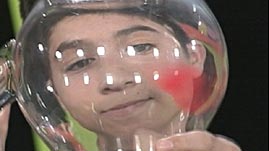Teachers' Domain - Digital Media for the Classroom and Professional Development
User: Preview


Source: ZOOM
Defy Gravity! Centripetal Force (Document)
(humming) (gasps)
RACHEL: Hey, ZOOMers, do you think you can defy gravity? Well, Erica R. of Brooklyn, New York, wants us to try. She wants us to see if we can carry a ball in a pitcher. But the trick is the pitcher has to be upside down like this. It's best to use a plastic pitcher for this challenge.
KENNY: How are we going to do this?
RACHEL: It's hard.
KENNY: If you put it in tip it upside down it's going to fall over... fall out.
RACHEL: Whoops.
KENNY: So there has to be a way we can keep it up in...
RACHEL: This is hard, because there's no, like little thing it can, like, hook on or something.
KENNY: What if we... ran really fast? That's not going to...
RACHEL: Yeah, that would work. You know, like a hula hoop, kind of... Okay, say I was moving it. If you keep spinning, it will stay on you. You will stay in it.
Well, I just thought of a really cool idea. This pitcher is a hula hoop and this is, like, me or you. And so it could be like this. You could start going like that. Like a hula, and then after it really starts to twirl we can... whoops.
KENNY: Tip it upside down?
RACHEL: We can go like this and it will still be swirling. We just have to keep going like this and we can walk around.
KENNY: Let's try it.
RACHEL: Okay.
KENNY: Whoa, I was doing it for a second!
RACHEL: You really have to get it going, though and really spin it.
KENNY: I did it!
RACHEL: You did?
KENNY: Ready, watch.
RACHEL: (gasping) Oh, my gosh, it works! First I have to do it, though.
KENNY: Good idea.
RACHEL: Thanks.
KENNY: Let's see if we can get it to work now. Ready, watch. I did it!
RACHEL: You did?
KENNY: Yup, for a little bit.
RACHEL: Ah, I turned as soon as you did it. Here, do it again.
KENNY: Okay.
RACHEL: These balls are bouncy.
KENNY: (humming fanfare)
RACHEL: Oh, my gosh, Kenny, you did it! It works!
KENNY: I know, cool.
RACHEL: Good job.
KENNY: We thought it was pretty hard to get the ball to stay in this pitcher. But we found that it worked really well with this wide pitcher. Watch this.
The wide pitcher is easier than the narrow pitcher because when I swirl it the ball gets trapped in this wide space and it's harder for it to fall out. Try it at home.
 Loading Standards
Loading Standards Teachers' Domain is proud to be a Pathways portal to the National Science Digital Library.
Teachers' Domain is proud to be a Pathways portal to the National Science Digital Library.
